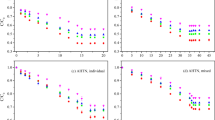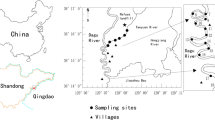Abstract
Synthetic musks (SMs) are fragrance additives widely used in personal care products. SMs and their transformation by-products may reach the environment even after wastewater treatment, resulting in ecological and health concerns. The identification and toxicity assessment of SM by-products generated from different chemical and biological treatment processes have been rarely studied. This study established a 3D-QSAR model based on SMs’ molecular structures (independent variable) and their lethal concentration (LC50) of mysid (dependent variable). The developed model was further used to predict the LC50 of SMs transformation by-products. Fifty-eight by-products of six common SMs (i.e., galaxolide (HHCB), tonalide (AHTN), phantolide (PHAN), traseolide (TRASE), celestolide (ADBI), and musk ketone (MK)) generated from biodegradation, photodegradation, advanced oxidation, and chlorination were identified through literature review and lab experiment as the model inputs. Predicted LC50 results indicated that the toxicity of 40% chlorination by-products is higher than their precursors. Biodegradation is an effective method to treat AHTN. The advanced oxidation may be the best way to treat HHCB. This is the first study on biotoxicity of SM transformation by-products predicted by the 3D-QSAR model. The research outputs helped to provide valuable reference data and guidance to improve management of SMs and other emerging contaminants.
Graphical abstract





Similar content being viewed by others
Data Availability
The datasets generated and/or analyzed that support the findings of this study are available from the corresponding author upon reasonable request.
References
Borch J, Axelstad M, Vinggaard AM, Dalgaard M (2006) Diisobutyl phthalate has comparable anti-androgenic effects to di-n-butyl phthalate in fetal rat testis. Toxicol Lett 163(3):183–190. https://doi.org/10.1016/j.envres.2011.01.015
Chen C, Zhou Q, Liu S, Xiu Z (2011) Acute toxicity, biochemical and gene expression responses of the earthworm Eisenia fetida exposed to polycyclic musks. Chemosphere 83(8):1147–1154. https://doi.org/10.1016/j.chemosphere.2011.01.006
Chen Y, Cai X, Jiang L, Li Y (2016) Prediction of octanol-air partition coefficients for polychlorinated biphenyls (PCBs) using 3D-QSAR models. Ecotoxicol Environ Saf 124:202–212. https://doi.org/10.1016/j.ecoenv.2015.10.024
European Union Risk Assessment Report, 2008. https://echa.europa.eu/documents/10162/947def3b-bbbf-473b-bc19-3bda7a8da910 (Accessed 6 March 2021).
Fan B, Wang X, Li J, Gao X, Li W, Huang Y, Liu Z (2019) Deriving aquatic life criteria for galaxolide (HHCB) and ecological risk assessment. Sci Total Environ 681:488–496. https://doi.org/10.1016/j.scitotenv.2019.05.033
Fang Y, Cai L, Lin F, Lu Z (2008) Degradation of synthetic musk ketone in water with ozone oxidation. Chinese J Environ Eng 2(8):1049–1052 in Chinese). https://kns.cnki.net/kcms/detail/detail.aspx?dbcode=CJFD&dbname=CJFD2008&filename=HJJZ200808008&v=zFRMwSVP%25mmd2FVYN1b%25mmd2Fyz89Byia%25mmd2FGZAwMQkCD9scNRrpUD4yf6SDne5mG1kcNQH13nU2
Gao M, Liu Y, Dong Y, Song Z (2021) Effect of polyethylene particles on dibutyl phthalate toxicity in lettuce (Lactuca sativa L.). J Hazard Mater 401:123422. https://doi.org/10.1016/j.jhazmat.2020.123422
Gatermann R, Hühnerfuss H, Rimkus G, Attar A, Kettrup A (1998) Occurrence of musk xylene and musk ketone metabolites in the aquatic environment. Chemosphere 36(11):2535–2547. https://doi.org/10.1016/S0045-6535(97)10208-9
Gu W, Zhao Y, Li Q, Li Y (2019) Environmentally friendly polychlorinated naphthalenes (PCNs) derivatives designed using 3D-QSAR and screened using molecular docking, density functional theory and health-based risk assessment. J Hazard Mater 363:316–332. https://doi.org/10.1016/j.jhazmat.2018.09.060
Homem V, Silva JA, Ratola N, Santos L, Alves A (2015) Long lasting perfume–a review of synthetic musks in WWTPs. J Environ Manag 149:168–192. https://doi.org/10.1016/j.jenvman.2014.10.008
Horii Y, Reiner JL, Loganathan BG, Kumar KS, Sajwan K, Kannan K (2007) Occurrence and fate of polycyclic musks in wastewater treatment plants in Kentucky and Georgia, USA. Chemosphere 68(11):2011–2020. https://doi.org/10.1016/j.chemosphere.2007.04.054
Hu XL, Liu G, Wei YT, Wang YH, Zhang TX, Yang S, Hu DF, Liu SQ (2018) Regional and seasonal effects on the gastrointestinal parasitism of captive forest musk deer. Acta Trop 177:1–8. https://doi.org/10.1016/j.actatropica.2017.09.021
Juksu K, Liu Y, Zhao J, Yao L, Sarin C, Sreesai S, Klomjek P, Traitangwong A, Ying G (2020) Emerging contaminants in aquatic environments and coastal waters affected by urban wastewater discharge in Thailand: an ecological risk perspective. Ecotoxicol Environ Saf 204:110952. https://doi.org/10.1016/j.ecoenv.2020.110952
Kooijman SALM (1987) A safety factor for LC50 values allowing for differences in sensitivity among species. Water Res 21(3):269–276. https://doi.org/10.1016/0043-1354(87)90205-3
Krzeminski P, Schwermer C, Wennberg A, Langford K, Vogelsang C (2017) Occurrence of UV filters, fragrances and organophosphate flame retardants in municipal WWTP effluents and their removal during membrane post-treatment. J Hazard Mater 323:166–176. https://doi.org/10.1016/j.jhazmat.2016.08.001
Kuhlich P, Göstl R, Teichert P, Piechotta C, Nehls I (2011) Transformations of polycyclic musks AHTN and HHCB upon disinfection with hypochlorite: two new chlorinated disinfection by-products (CDBP) of AHTN and a possible source for HHCB-lactone. Anal Bioanal Chem 399(10):3579–3588. https://doi.org/10.1007/s00216-011-4674-3
Lange C, Kuch B, Metzger JW (2015) Occurrence and fate of synthetic musk fragrances in a small German river. J Hazard Mater 282:34–40. https://doi.org/10.1016/j.jhazmat.2014.06.027
Li X, Chu Z, Yang J, Li M, Du M, Zhao X, Zhu Z, Li Y (2018) Synthetic musks: a class of commercial fragrance additives in personal care products (PCPs) causing concern as emerging contaminants. Adv Mar Biol 81:213–280. https://doi.org/10.1016/bs.amb.2018.09.008
Liu H, Sun P, Liu H, Yang S, Wang L, Wang Z (2015) Acute toxicity of benzophenone-type UV filters for Photobacterium phosphoreum and Daphnia magna: QSAR analysis, interspecies relationship and integrated assessment. Chemosphere 135:182–188. https://doi.org/10.1016/j.chemosphere.2015.04.036
Martin C, Moeder M, Daniel X, Krauss G, Schlosser D (2007) Biotransformation of the polycyclic musks HHCB and AHTN and metabolite formation by fungi occurring in freshwater environments. Environ Sci Technol 41(15):5395–5402. https://doi.org/10.1021/es0711462
Mersch-Sundermann V, Kevekordes S, Jenter C (1998) Lack of mutagenicity of polycyclic musk fragrances in Salmonella typhimurium. Toxicol in Vitro 12(4):389–393. https://doi.org/10.1016/S0887-2333(98)00007-1
Nakata H, Shinohara RI, Nakazawa Y, Isobe T, Sudaryanto A, Subramanian A, Tanabe S, Zakaria MP, Zheng G, Lam P, Kim EY, Min BY, We SU, Viet PH, Tana TS, Prudente M, Frank D, Lauenstein G, Kannan K (2012) Asia–Pacific mussel watch for emerging pollutants: distribution of synthetic musks and benzotriazole UV stabilizers in Asian and US coastal waters. Mar Pollut Bull 64(10):2211–2218. https://doi.org/10.1016/j.marpolbul.2012.07.049
Reihaneh SS, Jahan G (2013) Quasi 4D-QSAR and 3D-QSAR study of the pan class I phosphoinositide 3-kinase (PI3K) inhibitors. Med Chem Res 22(4):1587e1596–1587e1596. https://doi.org/10.1007/s00044-012-0151-6
Rimkus GG, Gatermann R, Hühnerfuss H (1999) Musk xylene and musk ketone amino metabolites in the aquatic environment. Toxicol Lett 111(1-2):5–15. https://doi.org/10.1016/S0378-4274(99)00190-3
Saillenfait AM, Sabate JP, Gallissot F (2006) Developmental toxic effects of diisobutyl phthalate, the methyl-branched analogue of di-n-butyl phthalate, administered by gavage to rats. Toxicol Lett 165(1):39–46. https://doi.org/10.1016/j.toxlet.2006.01.013
Sanchez-Prado L, Lourido M, Lores M, Llompart M, Garcia-Jares C, Cela R (2004) Study of the photoinduced degradation of polycyclic musk compounds by solid-phase microextraction and gas chromatography/mass spectrometry. Rapid Commun Mass Spectrom 18(11):1186–1192. https://doi.org/10.1002/rcm.1459
Santiago-Morales J, Gómez MJ, Herrera S, Fernández-Alba AR, García-Calvo E, Rosal R (2012) Oxidative and photochemical processes for the removal of galaxolide and tonalide from wastewater. Water Res 46(14):4435–4447. https://doi.org/10.1016/j.watres.2012.05.051
Tasselli S, Guzzella L (2020) Polycyclic musk fragrances (PMFs) in wastewater and activated sludge: analytical protocol and application to a real case study. Environ Sci Pollut Res 1-10:30977–30986. https://doi.org/10.1007/s11356-019-06767-7
Tseng WJ, Tsai SW (2019) Assessment of dermal exposures for synthetic musks from personal care products in Taiwan. Sci Total Environ 669:160–167. https://doi.org/10.1016/j.scitotenv.2019.03.046
USEPA, 2014. TSCA Work Plan Chemical Risk Assessment HHCB 1,3,4,6,7,8-Hexahydro-4,6,6,7,8,8-hexamethylcyclopenta-g-2-benzopyran. https://www.epa.gov/sites/production/files/201509/documents/hhcb_wp_ra_final_08_27_14.pdf. (Accessed 6 March 2021)
Vallecillos L, Sadef Y, Borrull F, Pocurull E, Bester K (2017) Degradation of synthetic fragrances by laccase-mediated system. J Hazard Mater 334:233–243. https://doi.org/10.1016/j.jhazmat.2017.04.003
Wang L, Liu X (2019) Degradation of aqueous polycyclic musk tonalide by ultraviolet-activated free chlorine. Processes 7(2):95. https://doi.org/10.3390/pr7020095
Wang X, Chu Z, Yang J, Li Y (2017a) Pentachlorophenol molecule design with lower bioconcentration through 3D-QSAR associated with molecule docking. Environ Sci Pollut Res 24(32):25114–25125. https://doi.org/10.1007/s11356-017-0129-5
Wang XL, Gu WW, Guo EM, Cui CY, Li Y (2017b) Assessment of long-range transport potential of polychlorinated Naphthalenes based on three-dimensional QSAR models. Environ Sci Pollut Res 24(17):14802e14818–14802e14818. https://doi.org/10.1007/s11356-017-8967-8
Winkler DA (2018) Sparse QSAR modelling methods for therapeutic and regenerative medicine. J Comput Aided Mol Des 32(4):497–509. https://doi.org/10.1007/s10822-018-0106-1
Wollenberger L, Breitholtz M, Kusk KO, Bengtsson BE (2003) Inhibition of larval development of the marine copepod Acartia tonsa by four synthetic musk substances. Sci Total Environ 305(1-3):53–64. https://doi.org/10.1016/S0048-9697(02)00471-0
Wu CY, Bai L, Gu F, Wei W, Guo LX, Wen DM (2018) Elimination of typical polycyclic musks in a full-scale membrane bioreactor combined with anaerobic–anoxic–oxic process in municipal wastewater treatment plant. Water Sci Technol 78(7):1459–1465. https://doi.org/10.2166/wst.2018.423
Zeng X, Xu L, Liu J, Wu Y, Yu Z (2018) Occurrence and distribution of organophosphorus flame retardants/plasticizers and synthetic musks in sediments from source water in the Pearl River Delta. China Environ Toxicol Chem 37(4):975–982. https://doi.org/10.1002/etc.4040
Zhang S, Yang Q, Li Z, Wang W, Zang X, Wang C, Wang Z (2018) Solid phase microextraction of phthalic acid esters from vegetable oils using iron (III)-based metal-organic framework/graphene oxide coating. Food Chem 263:258–264. https://doi.org/10.1016/j.foodchem.2018.04.132
Zhang W, Wei Z, Lin C, Wang Z, Zheng Z, Li S (2019) 3D-QSAR study of the phenylsulfamic acid derivatives as HPTPβ inhibitors. J Mol Struct 1186:11–22. https://doi.org/10.1016/j.molstruc.2019.02.107
Zhang W, Sun R, Zhao X, Li Y (2020) Environmental conversion path inference of new designed fluoroquinolones and their potential environmental risk. Arch Environ Contam Toxicol 78(2):310–328. https://doi.org/10.1007/s00244-019-00672-3
Zhao Y, Li Y (2018) Modified neonicotinoid insecticide with bi-directional selective toxicity and drug resistance. Ecotoxicol Environ Saf 164:467–473. https://doi.org/10.1016/j.ecoenv.2018.08.055
Zhao W, Xing J, Chen D, Jin D, Shen J (2016) Electrochemical degradation of musk ketone in aqueous solutions using a novel porous Ti/SnO2-Sb2O3/PbO2 electrodes. J Electroanal Chem 775:179–188. https://doi.org/10.1016/j.jelechem.2016.05.050
Zhao Y, Gu W, Li Y (2018) Molecular design of 1, 3, 5, 7-TetraCN derivatives with reduced bioconcentration using 3D-QSAR modeling, full factorial design, and molecular docking. J Mol Graph Model 84:197–214. https://doi.org/10.1016/j.jmgm.2018.07.006
Zhu T, Wu J, He C, Fu D, Wu J (2018) Development and evaluation of MTLSER and QSAR models for predicting polyethylene-water partition coefficients. J Environ Manag 223:600–606. https://doi.org/10.1016/j.jenvman.2018.06.039
Funding
Special thanks go to the Natural Sciences and Engineering Research Council of Canada (NSERC) and Canada Foundation for Innovation (CFI) for financing and supporting this research.
Author information
Authors and Affiliations
Contributions
XL initiated the research, conducted data collection and model development, analyzed the results, and generated the manuscript draft. GL performed the chlorination experiment. BC conducted data analysis and edited the manuscript. WL edited the manuscript. BZ guided XL throughout the research as supervisor and principle investigator of the manuscript involved research projects and finalized the manuscript. All authors read and approved the final manuscript.
Corresponding author
Ethics declarations
Ethics approval
Not applicable.
Consent to participate
Not applicable.
Consent to publish
Not applicable.
Competing interests
The authors declare no competing interests.
Additional information
Responsible Editor: Ludek Blaha
Publisher’s note
Springer Nature remains neutral with regard to jurisdictional claims in published maps and institutional affiliations.
Supplementary information
ESM 1
(DOCX 228 kb)
Rights and permissions
About this article
Cite this article
Li, X., Li, G., Chen, B. et al. 3D-QSAR-aided toxicity assessment of synthetic musks and their transformation by-products. Environ Sci Pollut Res 28, 57530–57542 (2021). https://doi.org/10.1007/s11356-021-14672-1
Received:
Accepted:
Published:
Issue Date:
DOI: https://doi.org/10.1007/s11356-021-14672-1




